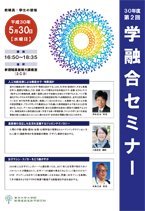AY2018 2nd Gakuyugo Seminar
- Date&Time:
- May 30, 2018 16:50~18:35
- Venue:
- Large Lecture Room (2C0), New Frontier Science Bldg.

Design of functional molecules and materials using artificial intelligence technology
Professor Koji TsudaThe design of new molecules and materials with desired functions is of great scientific and industrial significance. Important targets include biopolymers such as nucleic acids and proteins, inorganic materials such as metals, ceramics, and nanoparticles, and low-molecular-weight organic compounds that are important in drug discovery. Automatic design using artificial intelligence techniques such as Bayesian optimization and Monte Carlo tree search has attracted much attention in recent years, but it has not yet penetrated the scientific and industrial communities. In this talk, I will point out that design problems for various targets can be handled on the common mathematical basis of black box optimization. Furthermore, I will show that various molecular and material design problems can be solved by a powerful combination of machine learning from data, discrete algorithms for efficient exploration of huge spaces, first-principles calculations for accurate prediction of physical properties from physical laws, and verification experiments in wet labs.

Geron Technology Helps Seniors Live Independently
Lecturer Misato NiheiOrganisms that have transformed into anhydrobiosis, a physiological state in which they do not die even if they are parched, can not only withstand several years or more of aridity while maintaining the ability to revive, but can also withstand a variety of stresses, including high and extremely low temperatures, radiation, high pressure, and vacuum. The nemuri chironomid (Polypedilum vanderplanki), which inhabits semi-arid regions of Africa, is the largest animal with anhydrobiosis capacity. In this talk, I would like to discuss the latest information on the study of the nemuriid lily. In particular, I will emphasize that the use of the lacewing as a model organism has opened the door to the identification of the gene responsible for anhydrobiosis.

How to make molecular machines and nanocars work
Professor Katsuhiko Ariga
In 2016, molecular machines were awarded the Nobel Prize, and in 2017, the world's first nanocar race was held. How to drive a single molecule machine or car? We will show the two extremes: one by direct stimulation of molecules with STM chips, and the other by integrating molecular machines at interfaces and driving them with macroscopic stimuli such as hand movements.
*The contents of this page were developed based on a machine translation.

